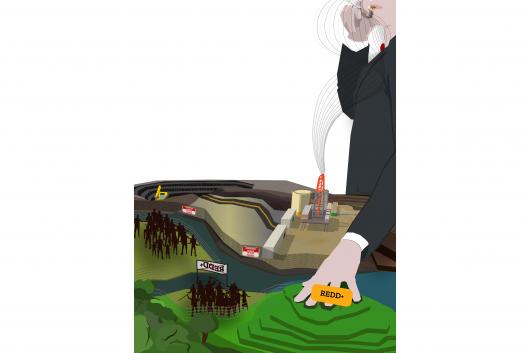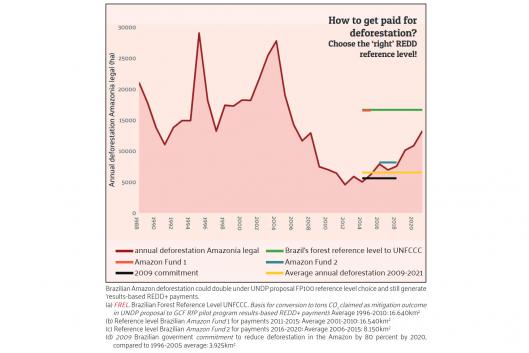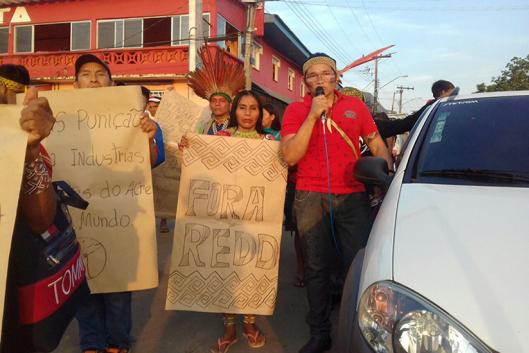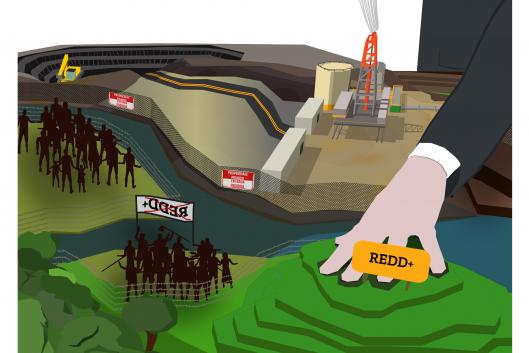This article is part of the publication 15 Years of REDD:
A Mechanism Rotten at the Core
>>> Download the publication in pdf
REDD has dominated international forest policy for the past 15 years with the promise of making trees more valuable standing than cut down and in doing so, provide a rapid and cheap way of reducing greenhouse gas emissions. The companies that pocket billions from turning forests into monoculture plantations, cattle pastures or destroying them for mines, hydrodams and other infrastructure, were not interested in REDD. REDD has undoubtedly failed to reduce large-scale deforestation. Yet, focussing on the obvious failure of REDD, provides an incomplete picture of its damaging legacy.
REDD is the abbreviation in English for 'Reducing Emissions from Deforestation and Forest Degradation'; it has dominated international forest policy for the past 15 years. The starting point for REDD was the assumption that offering financial rewards will convince those responsible for destroying forests to drop their plans; in exchange for the REDD payment, they would protect the forest instead. REDD would thus make the trees worth more standing than cut down and in doing so, provide a rapid and cheap way of reducing greenhouse gas emissions. For REDD proponents, all that was needed to end deforestation, was an offer of financial rewards to protect, not destroy.
But the companies that pocket billions from turning forests into oil palm or soy plantations, cattle pastures or destroying them for mines, hydroelectric reservoirs, highways and other infrastructure, were not interested in REDD. Some were not interested, because they could still earn much more if they continued to destroy forests. Anyone "who responds to purely economic incentives would opt for palm oil," as the pro-REDD group Ecosystem Market Place already wrote in 2014. Others were not interested because their deforestation was illegal. Which company was going to apply for REDD payments, saying it would be willing to drop plans to illegally destroy forests? There were also those who engaged in deforestation mainly as a way of claiming ownership to land, or strengthening their ownership claims. To this group, the promise of REDD payments was of little interest because their primary motivation to clear land was not immediate financial profit. (1)
15 years on, the concept introduced into the UN climate negotiations with the promise that it would lead to rapid and cheap reduction of emissions from tropical forest destruction, has failed to drive down large-scale deforestation. In countries like Brazil, Peru or the Democratic Republic of Congo, deforestation has even been rising since REDD was introduced. (2)
This failure of REDD to reduce deforestation has been widely documented. (3) A recent study on the effectiveness of German government funding for REDD explains why REDD success stories nonetheless abound: a “downward adjustment of expectations” about what REDD was to achieve has allowed proponents of REDD to construct "seemingly positive effects in the context of the instrument’s limited appeal." The price for this adjustment: "diluting the broader goal of stopping deforestation."(4)
Focussing only on the obvious failure of REDD to help bring down forest loss, however, seems to present an incomplete picture of the instrument's damaging legacy.
>>> Also see "What's hiding behind the letters R – E – D - D?" <<<
REDD is not a failure for everyone
REDD has not failed for those who used it as a tool to increase control over land cultivated by forest-dependent communities. The story that 'slash-and-burn' agriculture is destroying the forest; that peasant farming is causing deforestation and that forest peoples' cultivation practises need to be 'modernized' is – despite being false and reinforcing colonial patterns of domination – even more widely accepted today than it was 15 years ago. (5) What's more: because almost all REDD activities focus on changing how peasants and forest peoples use forests, not on large-scale deforestation, corporate destruction has been made less visible as a result of REDD.

REDD, and particularly its latest incarnation called 'nature-based solutions' (NbS) or 'nature climate solutions', also did not fail the fossil fuel industry. REDD has provided an excuse for this industry to continue to destroy the underground carbon stores that are at the core of both, their business model and climate breakdown. With REDD, and now NbS, oil, coal and fossil gas companies claim that they can continue their profitable destruction without damaging the climate. All they have to do is pay someone who claims to be saving carbon elsewhere. (6) Airlines, mining companies, agro-industries, fertilizer and food corporations, among others, have also enlisted REDD as a strategy to maintain the capitalist model of fossil fuel-dependent modes of production and consumption from which they profit.
The reality, however, is that it is impossible to compensation the climate impact that is caused when carbon is released from underground carbon deposits which have taken millions of years to form. Pretending that such compensation can be achieved through paying for REDD activities such as planting more trees or avoiding allegedly planned deforestation, is a dangerous illusion (see Is All Carbon the Same? Fossil Carbon, Violence and Power). By nurturing that illusion, REDD helps delay unavoidable discussions about ending fossil fuel burning, and in doing so, becomes itself a driver of climate breakdown.
Last but not least, consulting firms, international conservation NGOs and think tanks all have benefited from industrialized countries' and philanthropies' generous REDD funding programmes and corporate carbon offset purchases. (7) Specialized REDD sales agencies, private sector REDD project owners, certification standard developers and auditing companies, too, have carved out a lucrative niche for themselves. For them, REDD has not been a failure either.
REDD payments and carbon credits despite rising deforestation. How is this possible?
In 2019, the Green Climate Fund paid US$ 96.5 million to the government of Jair Bolsonaro in Brazil for allegedly reducing deforestation; since 2015, the German government's REDD Early Movers programme has transferred millions of dollars in REDD+ 'performance' payments to the governments of the Brazilian states of Acre (EUR 25 million / US$ 28 million) and Mato Grosso (EUR 44 million). This money was paid out even though deforestation has been rising in both states since REDD was introduced.
It has not been unusual for money to be paid out under REDD even though deforestation in the REDD programme or project area has been rising. This has to do with how 'success' is defined under REDD. In the case of the Green Climate Fund and REDD Early Movers payments, the governments involved agreed that REDD payments would be made as long as actual deforestation stayed below the average deforestation rate during some period of time in the past. In the case of the Brazilian states of Acre and Mato Grosso, the peak years of deforestation, 2004 and 2005, were included in the calculation. Deforestation had fallen drastically after those years, due to measures taken by the Brazilian government to reduce deforestation before REDD even existed. These included demarcation of Indigenous Peoples' territories and regular checks and fines for those found to be destroying forest illegally. When REDD was introduced, demarcation and law enforcement were replaced by the financial incentives logic on which REDD is based. The result: deforestation has been going up again.
Why are they still receiving REDD payments? Because the reference period was chosen so that a very high past deforestation could be shown. Therefore, even massive increases in deforestation after REDD was introduced are considered a REDD success: because deforestation was much higher at some time in the past, deforestation now – even if increasing – is less than it might have been without REDD.
The following image shows how the amount of the REDD payment depends on the negotiated reference numbers rather than on what actually happens in the forest. The dark green line indicates actual deforestation in the Brazilian Amazon. The coloured bars between 2014 and 2018 show different reference figures that were negotiated by the Brazilian government under different REDD initiatives. While the government missed its own 2009 commitment to reduce deforestation, it was still eligible for REDD funding. The amount of REDD funding received did depend less on the actual deforestation but on the difference between the actual deforestation and the negotiated reference number (the red line): The higher deforestation was assumed under the reference number, the more money was paid out under REDD - even if deforestation was rising.

Such jurisdictional REDD+ payments turn to the past to set an (inflated) baseline. Individual REDD+ projects use an even more dubious method: They compare actual deforestation within the project with the fictional story of how much deforestation would have happened without the REDD project. Several reports have exposed how this method has led to wild exaggeration of alleged emission savings. (17)
To make matters worse, REDD includes an inbuilt perverse incentive to exaggerate the forest destruction that allegedly would have happened without the REDD project: The bigger the hypothetical destruction, the bigger the difference between actual deforestation and what the project owner claims would have happened. And it is this difference that is turned into carbon credits that the project can sell. Many, if not most, existing REDD projects are based on implausible claims that forests were going to be destroyed without the REDD project. (18)
One such example is a REDD project managed by the world's largest conservation NGOs, The Nature Conservancy (TNC). TNC's REDD story is that without the project, TNC was going to log the forest and take out the most valuable timber in the coming years. This is very implausible, not least because two decades earlier, TNC had run a successful fundraising campaign to buy the land. In the fundraising campaign TNC had argued that buying the forest would protect it from the threat of logging. (19)
REDD as a tool to increase control over land used by forest peoples
Conflicts caused by REDD projects and their negative impact on forest peoples have been widely documented (20). Those conflicts frequently occur where projects are set up on land for which ownership is disputed. Conflicts arise, for example, when the REDD project places restrictions on the use of the land inside the REDD project area. Those imposing the restrictions tend to ignore that their claim to the land may be disputed and that forest peoples have long been using the territory now declared a REDD project. (21)

Restrictions often include bans on collecting firewood and farming practises using fire. Families affected by REDD projects have also reported access restrictions and confiscation of their livestock, for example where the REDD project does no longer allow people to use the land previously available to them as grazing land for their animals. Human-wildlife conflicts have also been reported to increase. Families affected by the Kasigau Corridor REDD project in Kenya, for example, reported that their crops are frequently destroyed by elephants without adequate compensation from the REDD project or the nearby National Park. Each claims the elephants were the others' responsibility with communities caught in the middle, left without compensation for their destroyed crops.
REDD has also made it easier for governments and conservation NGOs to justify programmes restricting practises such as shifting cultivation (“slash-and burn”). Many of these initiatives impose changes that make forest peoples' and peasant farming practises more dependent on technology and introduce farming methods controlled by corporations. They may promote practises that rely on the use of fertilizers and specialized, corporate-controlled seeds to supposedly increase yield per hectare (so that forest peoples will clear less land, the argument goes). This allows corporations, consultants and state agencies to increase control over land used by forest peoples and integrate peasant farming deeper into the globalized food commodities markets. This way, REDD contributes to peasants and forest-dependant peoples losing their autonomy and ancestral knowledge and culture over their land and life spaces.
Many REDD projects also use drones and cameras to monitor who is using land and how areas within the REDD project are used. (22) Sometimes, this monitoring is presented as something positive, a way of spotting intruders destroying forests inside Indigenous Peoples' territories illegally, for example. But isn’t this kind of monitoring a way of controlling how, where and when a community uses its territory, especially in areas where rights to the land are in dispute? Will forest peoples be fined if drone images taken by the REDD project show that they have cut trees on their territory, say, for construction of a community house? Will REDD project developers and consultants be able to collect crucial information from the digital mapping equipment they provide to community members involved in a REDD activity? Who controls this information?
Whether focused on forest communities’ farming practises or their forest use, REDD in its actual implementation has tended to put communities' autonomy and food sovereignty at risk in one way or another. It has also increased the influence that REDD project managers and consultants have over land use in forests inside the REDD project. By assigning a financial value to trees as carbon stores, REDD (and "nature-based solutions" more broadly) has also fuelled the grab for land as a way of cashing in on the new carbon value of the land. (23)
REDD as a driver of climate chaos
By proving a popular excuse to delay the end of fossil fuel burning, REDD is in fact driving the continuation and expansion of fossil fuel use. With pressure growing on corporations to show that they are 'taking action to reduce their climate impact', many present themselves as enthusiastic defenders of forests. Oil companies like Eni and Shell write about their "commitment to protecting and conserving forests" (Eni) and how "nature-based solutions can make a big contribution to Shell's ambition to be a net-zero emissions energy business by 2050, or sooner" (Shell).
Yet these same companies lack comparable enthusiasm to commit to "protecting and conserving" the underground carbon stores that they continue to destroy to extract oil, coal and gas. Where is the commitment to ending this destruction which is the principal cause of climate breakdown?
A REDD-Monitor article from December 2020 sums up why companies like Eni, Shell and many others are so enthusiastic about forests, REDD and "nature-based solutions" or nature climate solutions: "Big Polluters love them because they allow business as usual to continue. A series of oil and gas corporations including Shell, BP, Total, Gazprom, Eni, Petronas, PetroChina, and Occidental, have recently announced deliveries of “carbon neutral” liquified natural gas. Fossil fuels, of course, cannot be “carbon neutral” and claims that the emissions have been “offset” by buying carbon credits are pure greenwash. Climate scams such as REDD and natural climate solutions exist for exactly that purpose. To allow the fossil fuel industry to greenwash itself." (24)
It's allowing such greenwashing of continued fossil fuel burning, and the economic exploitation and socio-ecological and cultural destruction inextricably tied to fossil fuel extractivism that makes REDD much worse than just a colossal failure to help bring down forest loss.
Jutta Kill, WRM Secretariat
(1) Branford, S. & T. Borges (2021). Facebook enabling Amazon land grabbing, deforestation, finds investigation, and Branford, S. & M. Torres (2017) Crime and not enough punishment: Amazon thieves keep stolen public land. See also, Forest Trends (2014). Consumer Goods and Deforestation. An Analysis of the Extent and Nature of Illegality in Forest Conversion for Agriculture and Timber Plantations.
(2) For statistics about deforestation in the Brazilian Amazon, see the PRODES project of the Brazilian government: http://www.obt.inpe.br/OBT/assuntos/programas/amazonia/prodes and http://www.inpe.br/noticias/noticia.php?Cod_Noticia=5811; for deforestation trends in specific countries, see also the Global Forest Watch dataset here.
(3) See for example: Song, L. (2019). An even more inconvenient truth. Why carbon credits for forest preservation may be worth than nothing; on the World Bank FCPF, see REDD-Monitor (2022). Congo’s forest ‘emissions reductions programme’: Germany, Norway and UK taxpayers paying for nothing, as the World Bank-backed Forest Carbon Partnership Facility produces only ‘hot air’ emissions reductions; WRM (2019): REDD+: A Scheme Rotten at the Core; Milne, S. et al. (2019). Learning From ‘Actually Existing’ REDD+.
(4) German Institute for Development Evaluation (DEval) (2020). Germany’s Contribution to the Forest and Climate Protection Programme REDD+.
(5) Geist, H. and Lambin, E. F. (2002). Proximate causes and underlying driving forces of tropical deforestation. BioScience, 52 (2002), 143-150.
(6) REDD and Natural Climate Solutions are a massive distraction from real climate solutions. REDD-Monitor, 14 December 2021.
(7) Lund, J. F. et al. (2016). Promising Change, Delivering Continuity: REDD+ as Conservation Fad. World Development, and Svarstad H. & Benjaminsen, T. (2017). Nothing succeeds like success narratives: a case of conservation and development in the time of REDD, Journal of Eastern African Studies.
(8) See the 2020 talk 'Carbon Policy is not Climate Policy' by Larry Lohmann for some of the reasons why this assumption is questionable.
(9) WRM (2020). What could be wrong about planting trees?
(10) Counsell, S. (2021). Conservation NGOs Gift Polluters a Massive Land Grab called ‘Nature Based Solutions’. In: "Nature-based Solutions": Concealing a Massive Land Robbery. WRM Bulletin 255 – March/April 2021.
(11) See for example, 25 September 2020 letter from AIDESEP to the FCPF here: Letter N° 156-2020-Aidesep; Forest Peoples Programme (2021). La realidad de REDD en Peru. Entre el dicho y el hecho. and Rights and Resources Initiative (2018). Mai-Ndombe: Will the REDD+ Laboratory Benefit Indigenous Peoples and Local Communities?
(12) Forest Carbon Partnership Facility Takes Aim at Deforestation.
(13) Global Forest Coalition (2020). 15 years of REDD. Has it been worth the money?; WRM (2019). Misguided funding: Green Climate Fund support for REDD+;
(14) Cabello, J. (2013). The World Bank and 'market readiness': A 'carbon bible' for Southern countries.
(15) Fern and Forest Peoples Programme (2011). Smoke and Mirrors: A critical assessment of the Forest Carbon Partnership Facility.
(16) BioCarbon Fund "Who we are" and BioCarbon Fund - Initiative for Sustainable Forest Landscapes for an overview of who is involved in the different initiatives.
(17) See among others: Foodwatch (2021). Offsetting: 'climate neutral’ through forest protection? Assessment of the ‘climate neutral’ claims related to the Tambopata-area REDD project in Brazil nut concessions in Madre de Dios, Peru; West, Th. et al. (2020). Overstated carbon emission reductions from voluntary REDD+ projects in the Brazilian Amazon. PNAS.
(18) In addition to reports in (17) and (19), see also: REDD-Monitor (2017). Is Wildlife Work’s Mai Ndombe REDD+ project “additional”?; Seyller, C. et al. (2016). The 'Virtual Economy' of REDD+ Projects. International Forestry Review; Mulungu, K. (2021). The Luangwa Community Forests Project (LCFP) in Zambia. A review of the biggest REDD+ project in Africa financed by the Italian oil and gas company ENI. Report commissioned by Greenpeace Italy; REDD-Monitor (2019). Indonesia’s Katingan REDD project sells carbon credits to Shell.
(19) Most REDD+ activities are found in the global South, but there are also REDD+ projects in the US and Canada. See e.g., Ben Elgin (2020). These Trees Are Not What They Seem. How the Nature Conservancy, the world’s biggest environmental group, became a dealer of meaningless carbon offsets. Bloomberg Green.
(20) Among the REDD+ projects that have caused conflict are the Kasigau Corridor REDD project in Kenya, the Cardamon Mountains REDD projects in Cambodia, the Alto Mayo, Cordillera Azul and Tambopata REDD+ projects in Peru, the Russas and Valparaiso REDD projects in Brazil, the Katingan REDD+ project in Indonesia, the Mai Ndombe REDD projects in the DR Congo. REDD-Monitor has published articles on all of these projects. See also: Nel, A (2017). Contested carbon: Carbon forestry as a speculatively virtual, falteringly material and disputed territorial assemblage. Geoforum 81: 144–152; Flynn, G. (2021). REDD+ Projects Still Struggling to Live up to Expectations in Cambodia.
(21) See for example, REDD-Monitor (2021). Indigenous Kichwa community takes the Peruvian State and Cordillera Azul National Park to court; and Comunidad Kichwa Puerto Franco se reúne con representantes del Parque Nacional Cordillera Azul y exige que respeten sus derechos.
(22) Basta! & Amis de la Terre (2013): “REDD+ in Madagascar: You Can’t See the Wood for the Carbon"
(23) BBC News Brasil (2021): Documentário: BBC revela venda ilegal de terras na Amazônia pelo Facebook.
(24) REDD and Natural Climate Solutions are a massive distraction from real climate solutions
>> Back to the the publication 15 Years of REDD: A Mechanism Rotten at the Core index
